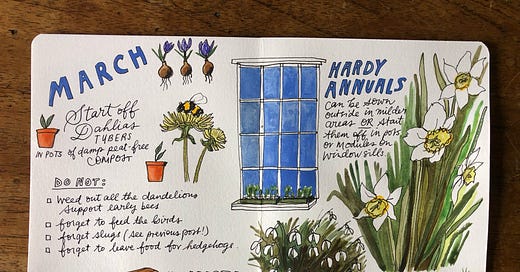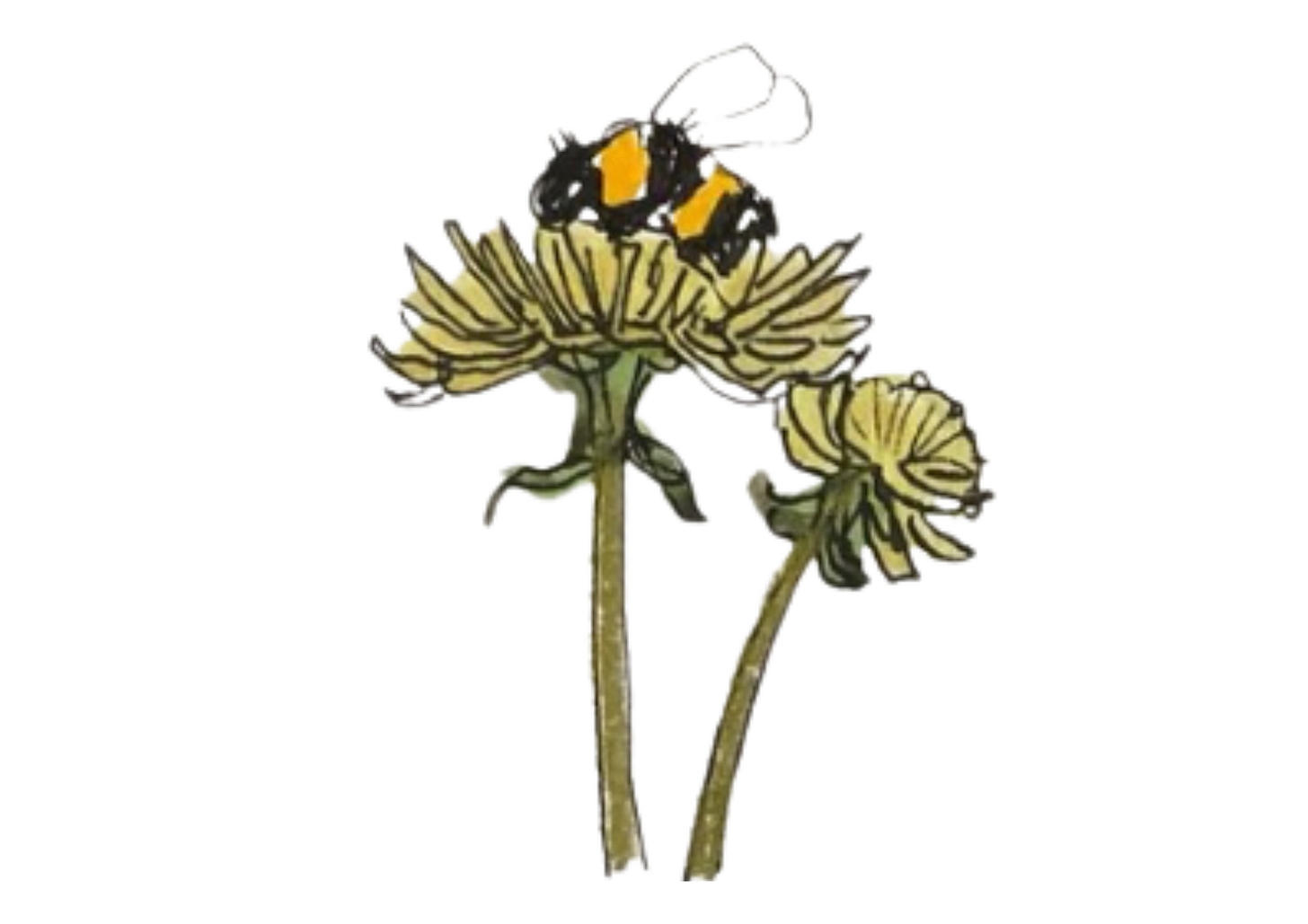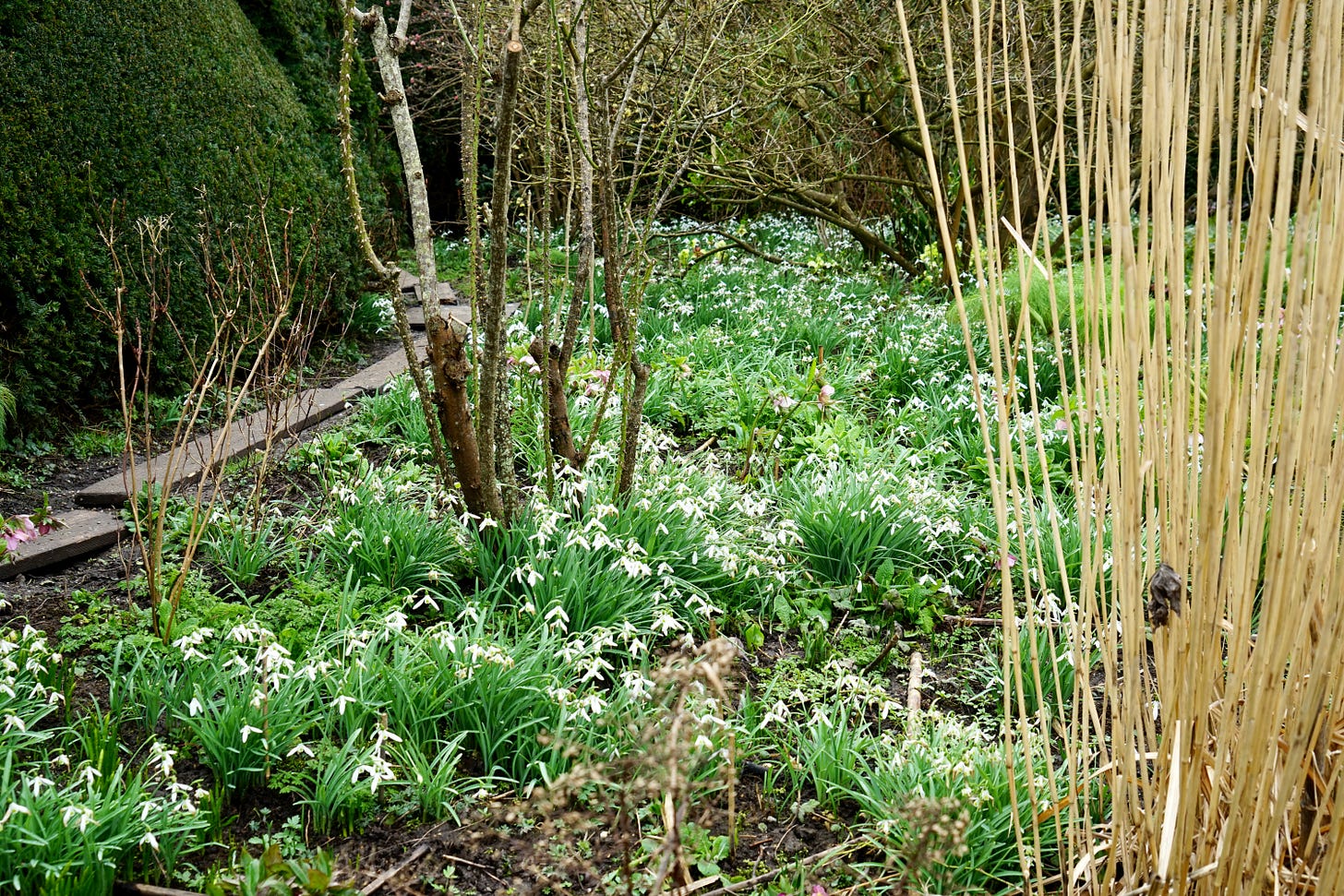How to garden in March
Spring is in the air and hedgehogs are looking for houses. Plus: poppy seed ice cubes and a chance to win tickets to Gravetye Manor
It is actually the first day of March. That’s it - January and February are done and dusted for the year and we can officially say that spring is here - well, meteorological spring anyway. We’ve got through the bulk of winter, we’ve wheeled round, and it’s time for the garden to start showing us that it’s waking up.
A new month means new what-to-dos and what-not-to-dos in the garden here in The Gardening Mind, and that also means another lovely new illustration by
- I adore this month’s illustrated journal pages: they absolutely fill me with cheer. I’m really hoping you’re enjoying them too.The sun is higher in the sky and the days are feeling noticeably longer, which is frankly brilliant. Have you sensed that excitement yet when it’s STILL LIGHT WAY AFTER 5 O’CLOCK? I feel we’ve had a few more blue skies over the last few days, and I’m still channelling the ‘celebrate while you can’ approach. Those funny old Imbolc decorations honestly did get me through a few endless days, and this month in the UK, on Thursday 20th March at 9:01 am precisely, we’ve got the Spring Equinox to look forward to.
Yes, you read that right. The actual equinox of actual spring. Friends, we are really, nearly there. For readers in the southern hemisphere, thank you for passing on your spring to us, and we’ll be thinking of you as we wheel around.
And remember, on Sunday mornings we get together on Show Us Your Plots - if you haven’t tried this out yet, why not make this March the month in which you do? It’s easy, honestly, and most importantly, it’s fun:
Come and join me at Gravetye Manor - and a ticket giveaway
This March is a busy one both in the garden, and the studio. The New Romantic Garden book launch is sold out but there are other events being announced. Thank you so much for supporting any or all of these: there are more details later in this post in the PS section.
On Thursday 25th April, I’ll be at Gravetye Manor where I’ll be talking about the book in between elevenses and a wonderful three course lunch: I’d absolutely love it if you could join me for this talk, followed by any questions you may have and then a chat over lunch. This also includes a signed copy of the book.
I have two tickets for this event worth £165 each to give away to one annual subscriber: if you’d like your name to go into the hat for this giveaway, please do let me know in the comments. I’ll be contacting the winner on Wednesday 5th March.
More details about this event at Gravetye Manor can be found here.
If you’re looking forward to the RHS Chelsea Flower Show, towards the end of the month I’ll be releasing more details about the garden I’m building there. Let’s just say the sleepless nights are really kicking in now as I talk to journalists about what to expect. If I tell you that some materials have unexpectedly come in at tens of thousands of pounds over budget, and we’ve spent the last two weeks looking for a solution, you’ll get a sense of those sleepless nights. Yikes.1
I’m reminding myself it’s really sort of Spring - and there’s a sense of life that’s positively bursting to fill the air
There’s a buzz in the air. The daffodils are starting to come out and the early bees are going bonkers for primrose pollen, and there are lots of things to get going on. But let’s not get overloaded with ‘to-dos’ - there are some things that can wait:
Yes, it is time for the roses to be pruned - see below - but don’t prune any spring-flowering such as choisya until after they have flowered, otherwise this year's display will be lost.
Don’t forget your plant supports - it’s way better to get them ordered or made now, and start putting them them around the garden as the perennials start to pop up. There’s a whole lot of options here. I promise you, you won’t regret if you get them at least ordered now. If you’re anything like me, you’ll leave it till everything is looking perfect, around about the end of June, and then just as you think nothing will flop this year, it does.
Don’t forget about the slugs. I’m going to be saying this every month - but forewarned is forearmed. Here’s my current battery of defences against these garden destroyers.
DON’T FORGET WILDLIFE:
Plant nectar and pollen rich plants and don’t weed out all the dandelions - which provide food for early bees such as the bee with the best name ever: the pantaloon bee:
Just look at those trousers. Otherwise known as the hairy-legged mining bee, these bees will thank you for turning a blind eye to a few dandelions. I leave them and then pull them up before they set seed - later in the year when there’s plenty of pollen elsewhere, I do dig them up straight away.
Temperatures in March can still fall well below zero at night, so invertebrates such as earthworms, beetles and caterpillars may still be taking shelter, so make sure there are still piles of sticks, or even a dead hedge if you have space, for them to nestle in.
Garden birds will have eaten all but the last of the berries, and with less invertebrate food available, they can often go hungry, just at a time when they need to be in good condition for breeding. Feed the birds - fatballs are a firm favourite.
Would you love to attract hedgehogs into your garden? I’m guessing the answer is yes (and apart from being very cute, hedgehogs love a good slug platter): if so, have you ever thought of installing or making a hedgehog house? More details in the PS section below. Hedgehog lovers suggest leaving out dogfood for them, but here in my garden a certain large yellow Labrador here prohibits that. I’m also thinking
And if you’re in an urban environment, hedgehogs would love a city pad - as long as they can get through your garden, that's the main thing, so a tiny hedgehog-sized opening in both sides of your boundary is what they need to go in their travels:
Hedgehogs come into gardens via holes in fences, gaps beneath gates and other small entrances - they don't need a big hole to travel through, around 13cm is enough.
They travel up to 2km a night in search of food and a mate, and will often return to the same garden – research has shown that hedgehogs spend more time in gardens where supplementary food is provided, and in those with open compost heaps. A male hedgehog may spend a week or so visiting the same garden and then move on to a different patch, while a female may raise young, so could spend several weeks nearby.
I’m not bothering to plant onion sets this year as I can’t tell the difference in flavour between home-grown and shop-bought ones, but I’d be interested to know if you are. This is a space-related decision: my veg beds are tiny and I’ve got too many dahlias that need to go somewhere…
Did you have snowdrops this year?
If you did, now is the time to divide them and plant them all over the garden. If you didn’t have them but saw pictures like this
and decided that next year is going to be the year of the snowdrop in your garden, then I suggest you get ordering them right now. Snowdrops are best planted ‘in the green’, which means they’ve just been pulled up and are positively stuffed with energy and raring to get going as soon as they’re replanted. Details of where I’m ordering mine are in the PS section below.
Cut back the last of the herbaceous perennials and grasses that you’ve left standing. Really now is the latest you can do this to avoid cutting into all that lovely new green growth that’s sprouting up from their base.
Free plants
One of the most satisfying March jobs is dividing perennials. Do you remember spotting any overgrown perennials last year - anything that just seemed a bit crowded? Now is the time to lift and divide them - many of them might be showing their first foliage now, or you might remember where they are anyway. First of all, dig around where you think the outside edge of the plant is, and lift it out. Now comes the fun bit: you can either gently pull the plant apart into chunks using your hands, or a garden fork. You can use a sharp spade or a pruning saw and slice it into clumps - a bit more brutal but the plant will withstand it. Anything that looks a bit rubbish - usually the stems in the middle of the plant - you can pop on the compost. Then replant the smaller clumps you’ve made - free plants!
Start off dahlia tubers in pots of damp peat-free compost, or if you’re in a milder spot, start getting them in the ground - I’ll probably wait till nearer the end of the month.
A favourite dahlia collection
You can still find some dahlias for sale: here’s one of my favourite collections that I planted at Water Lane:
It’s a really satisfying palette; there’s still time to buy these dahlias from the following suppliers. In this photo are:




















